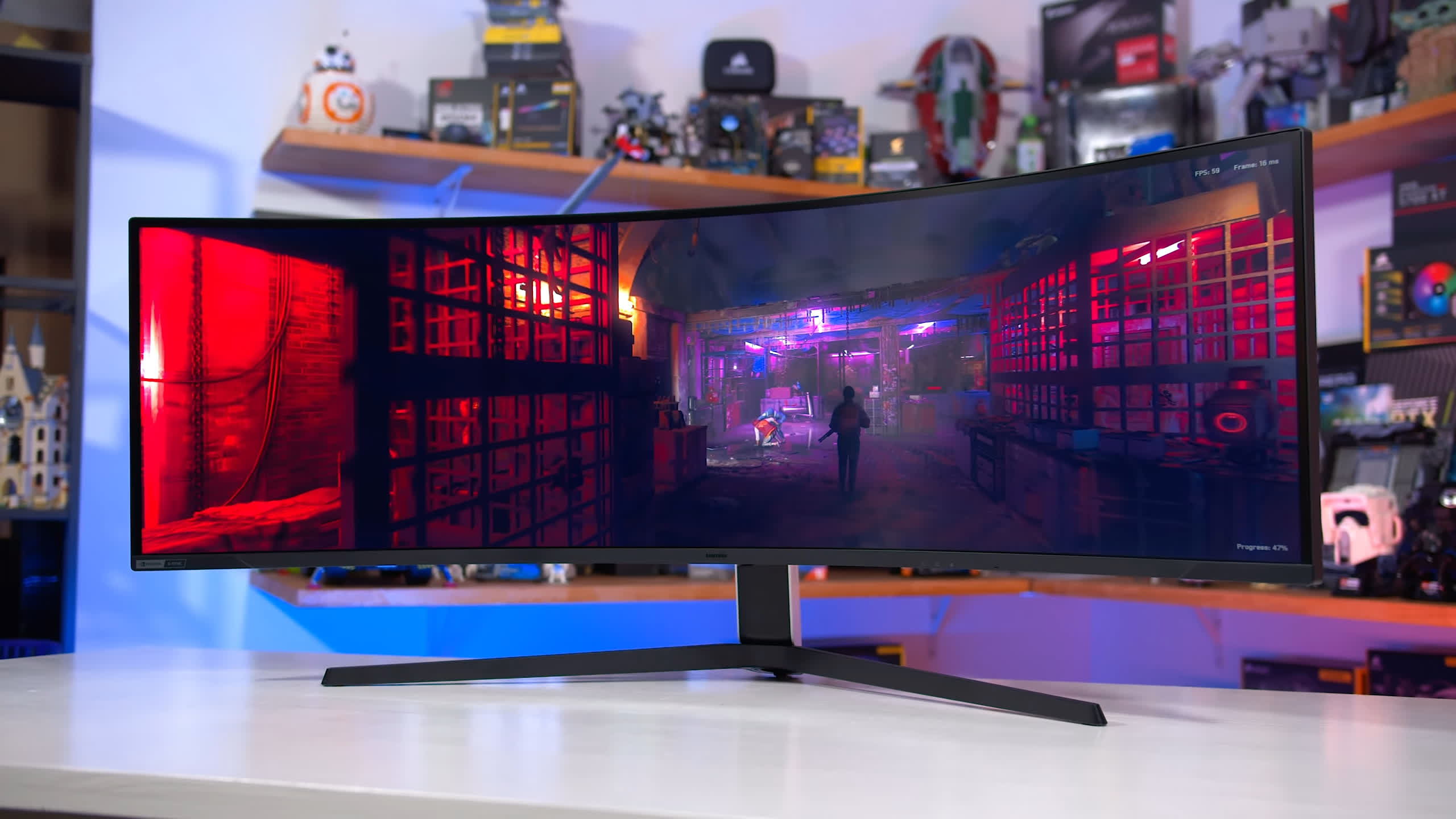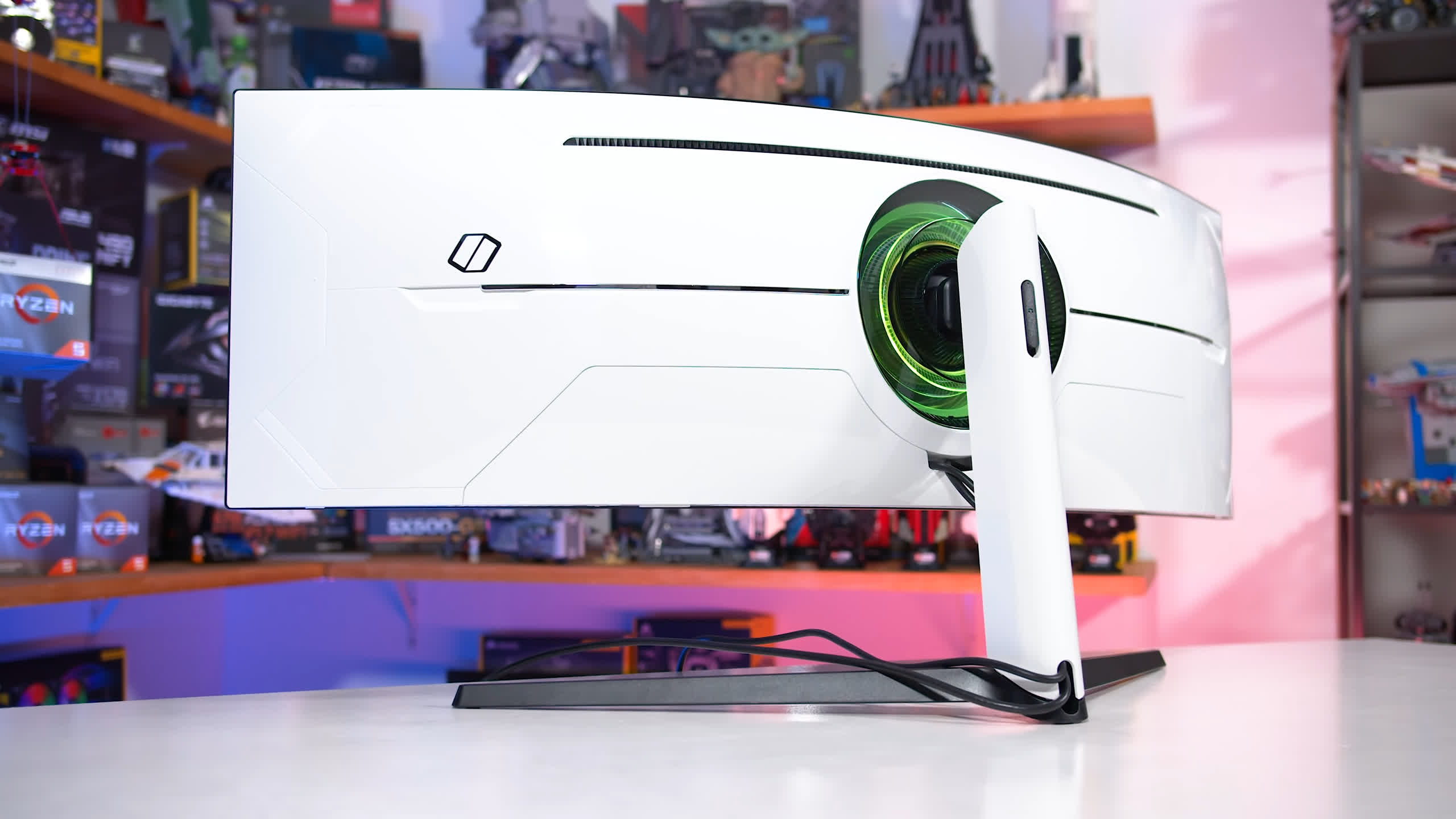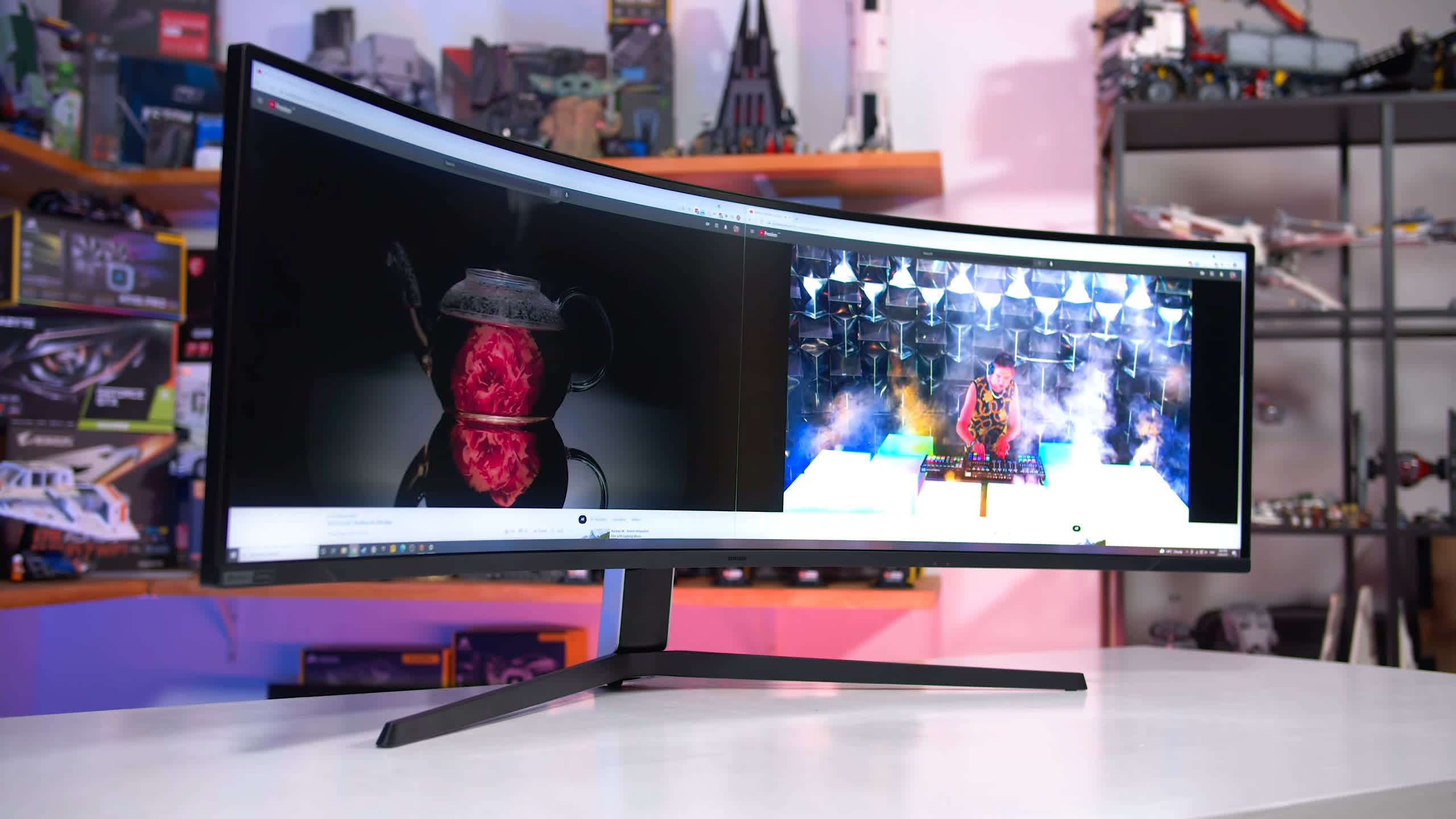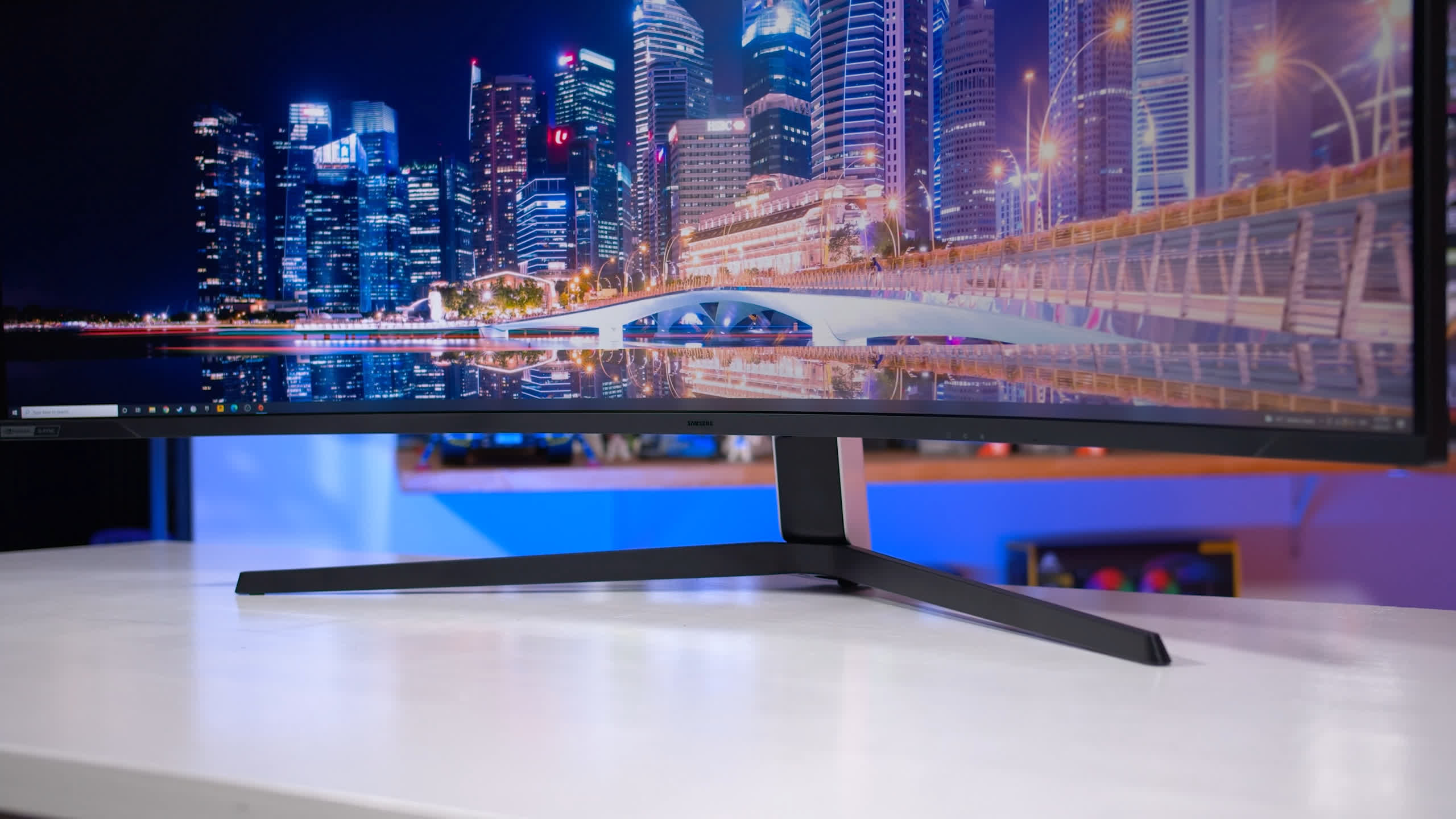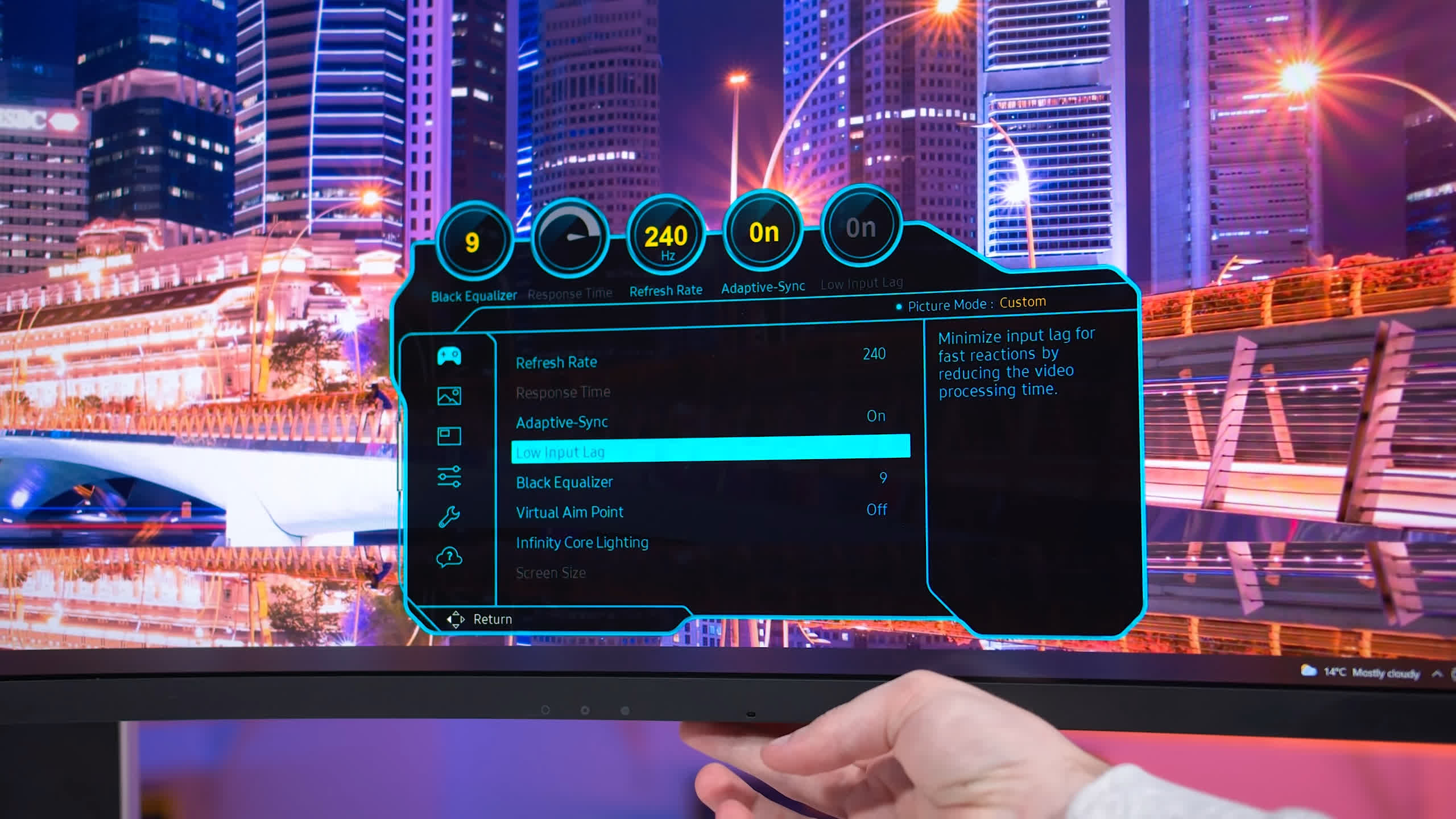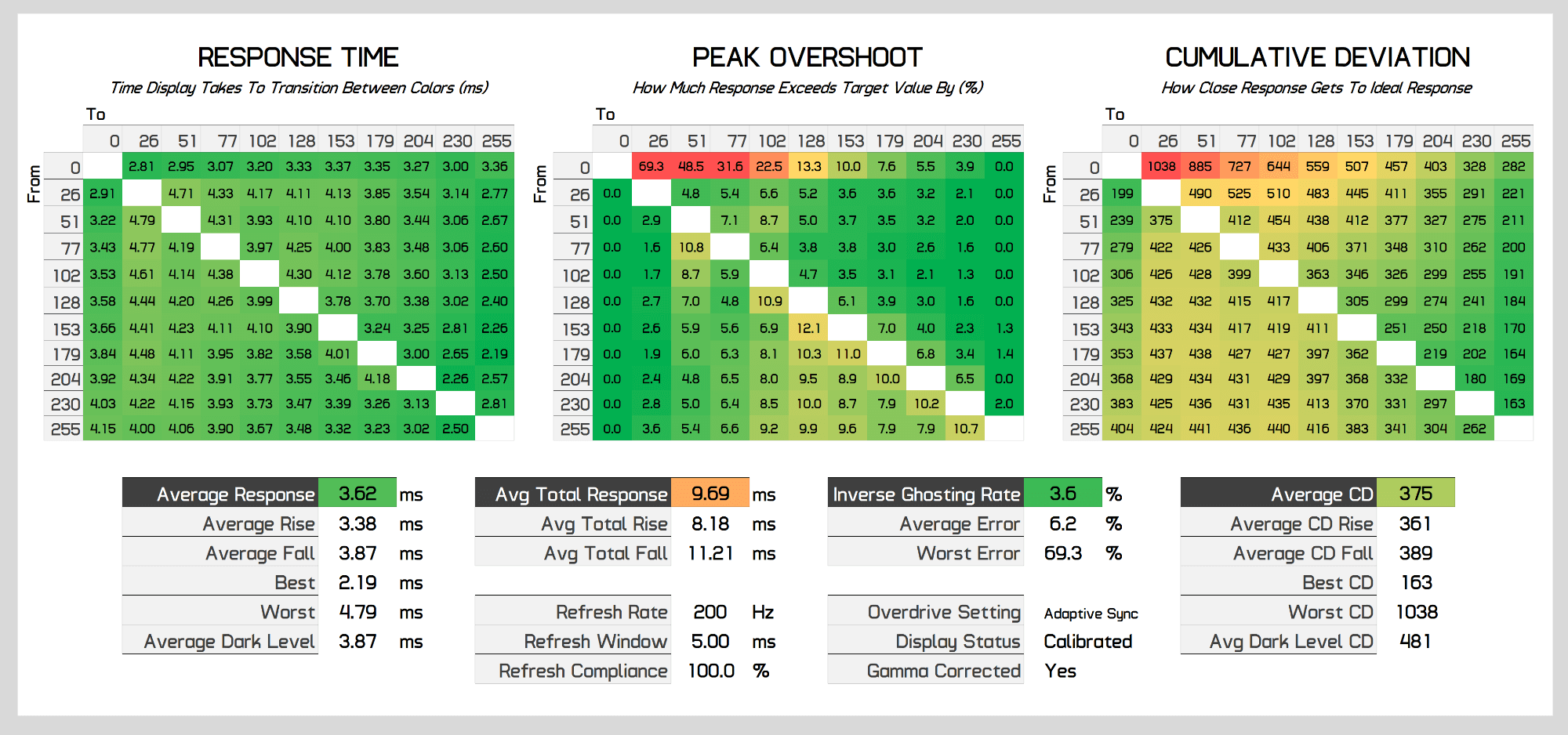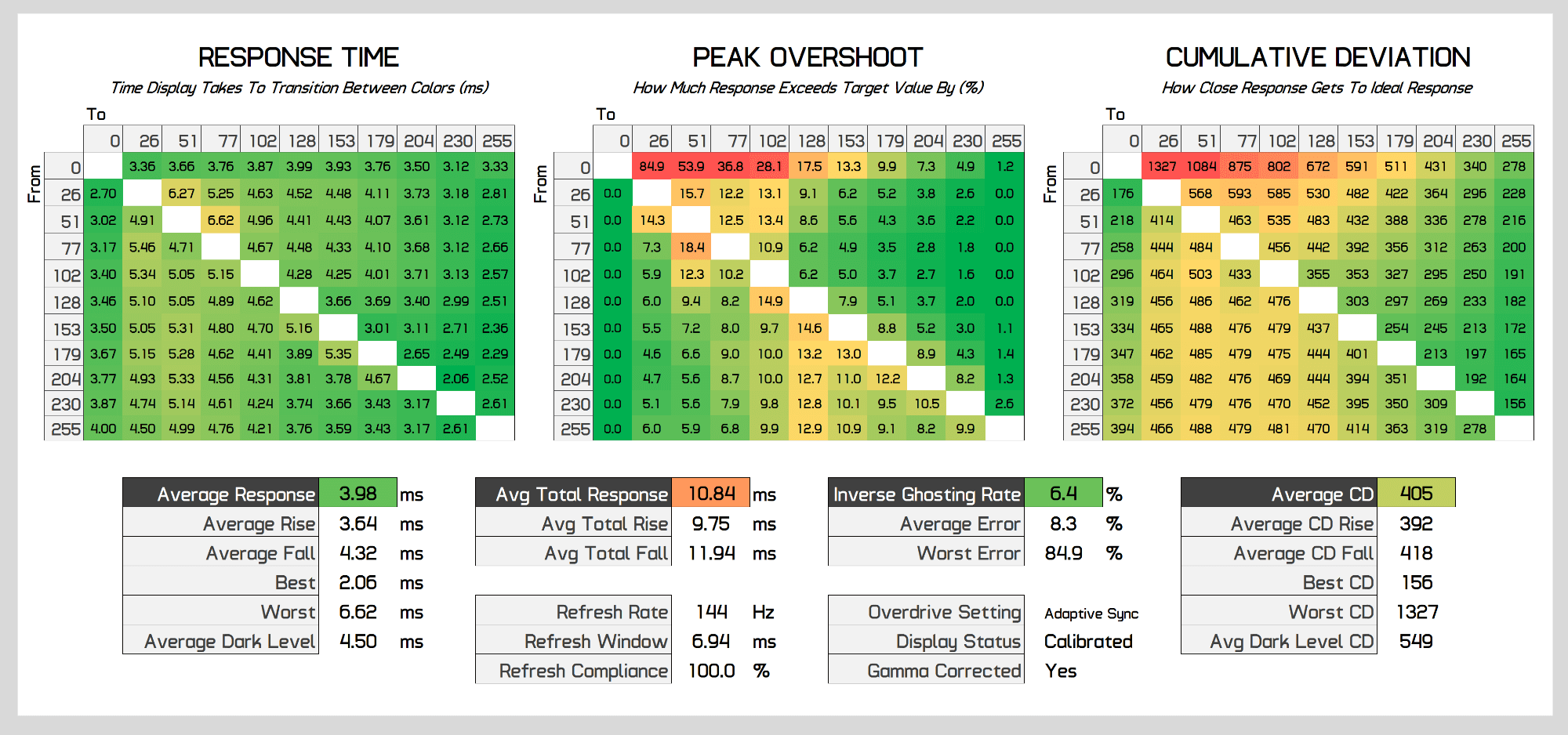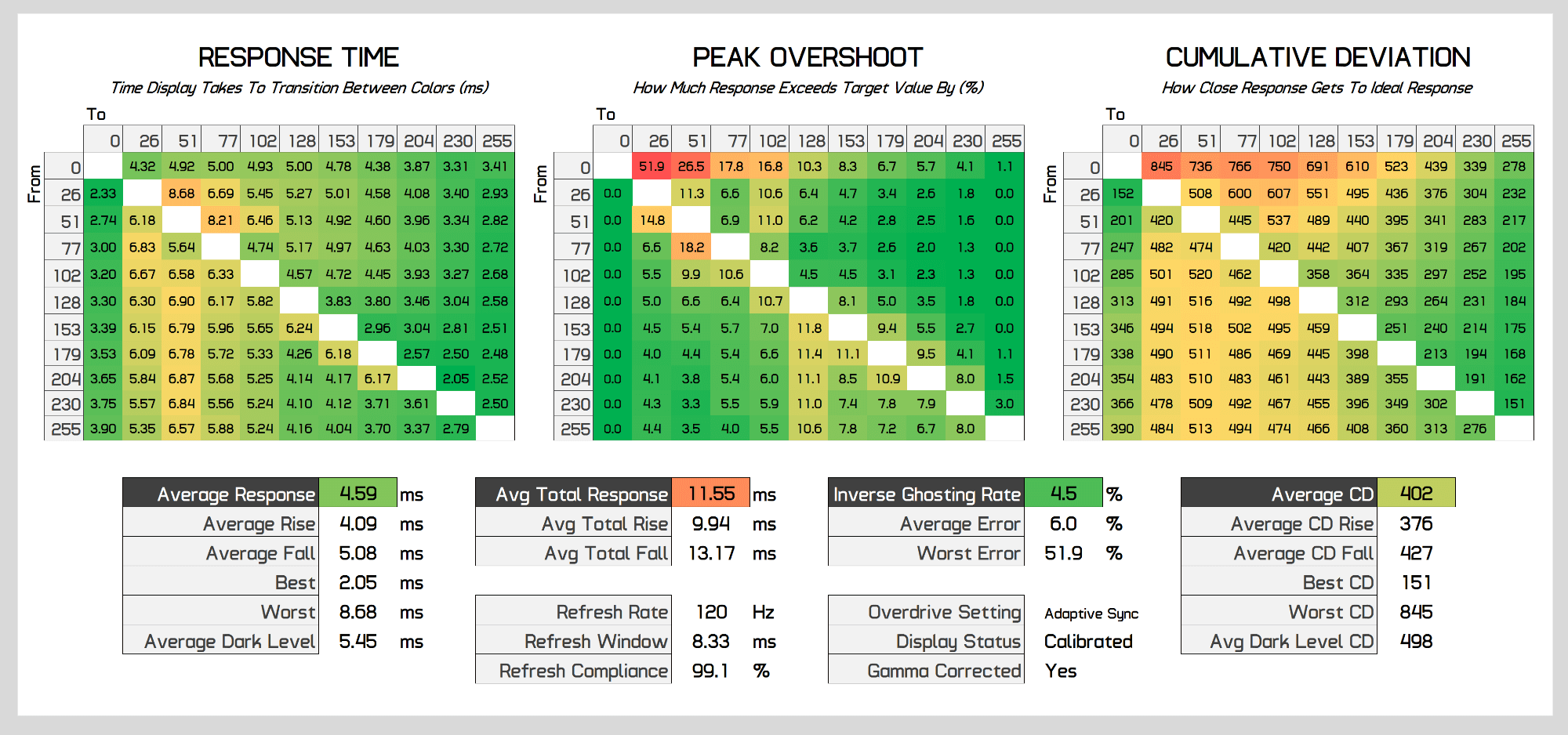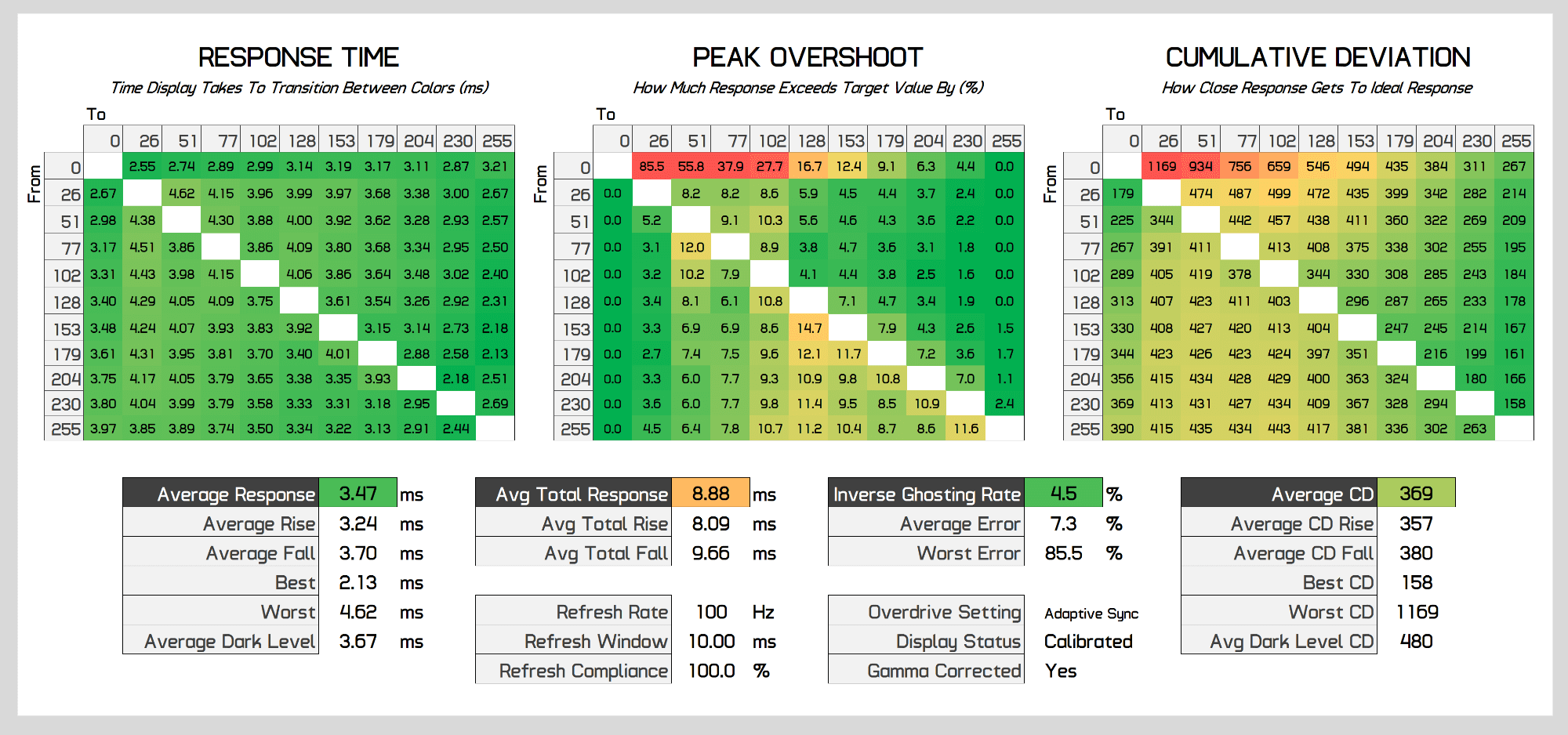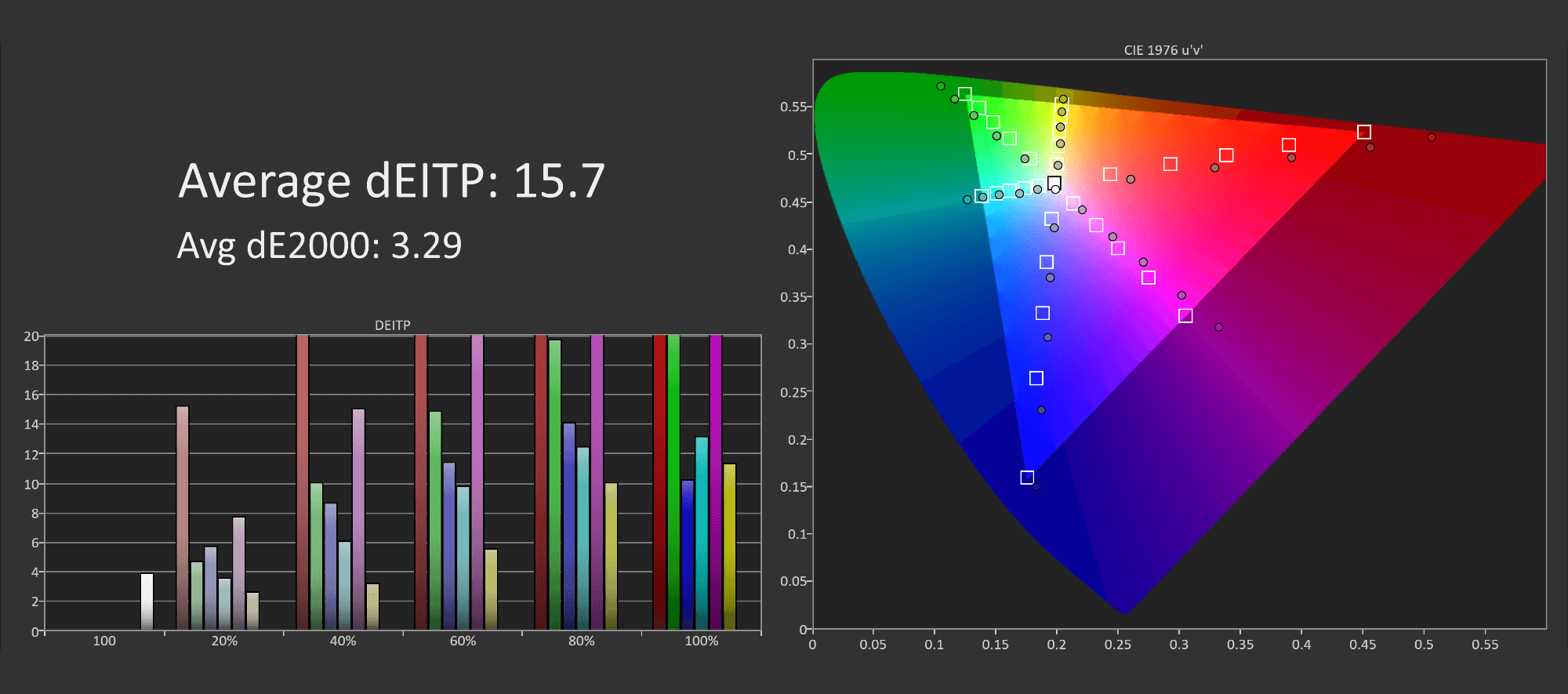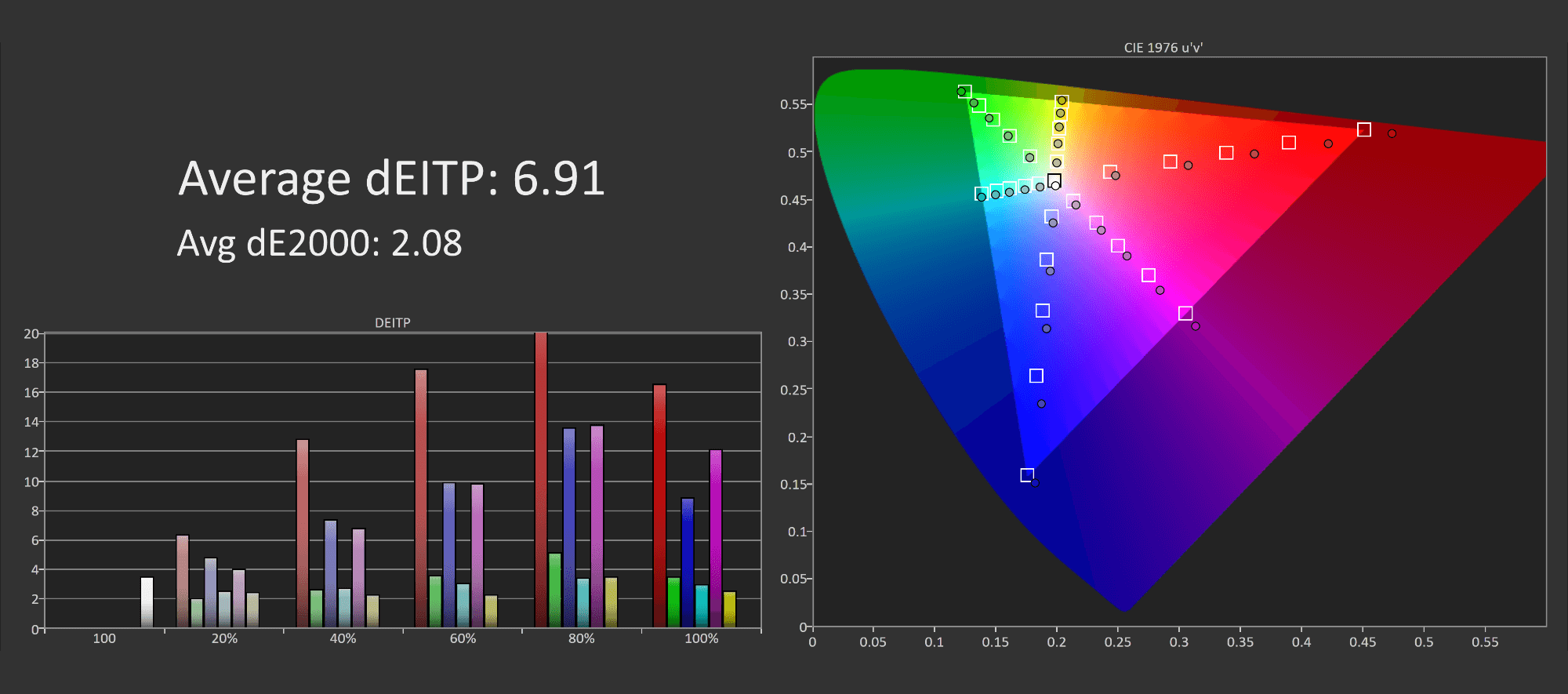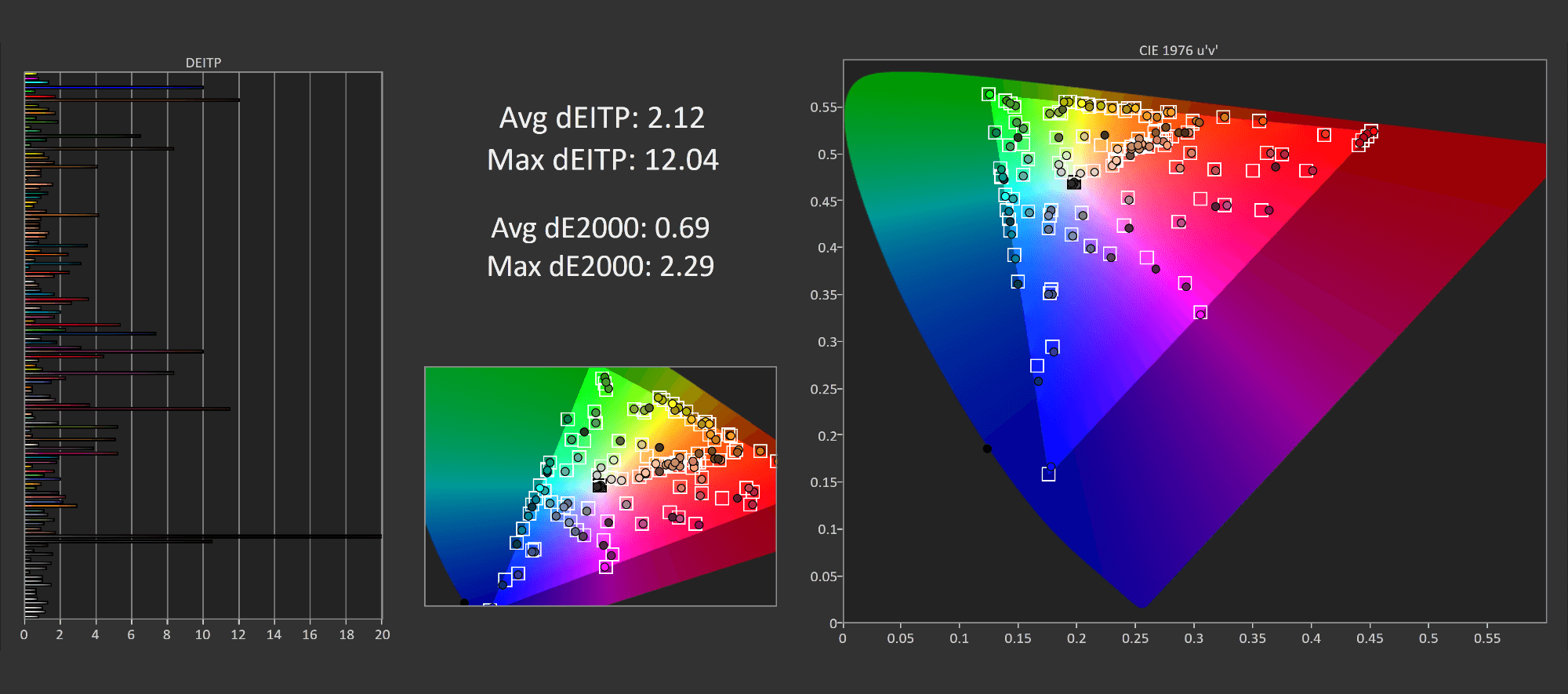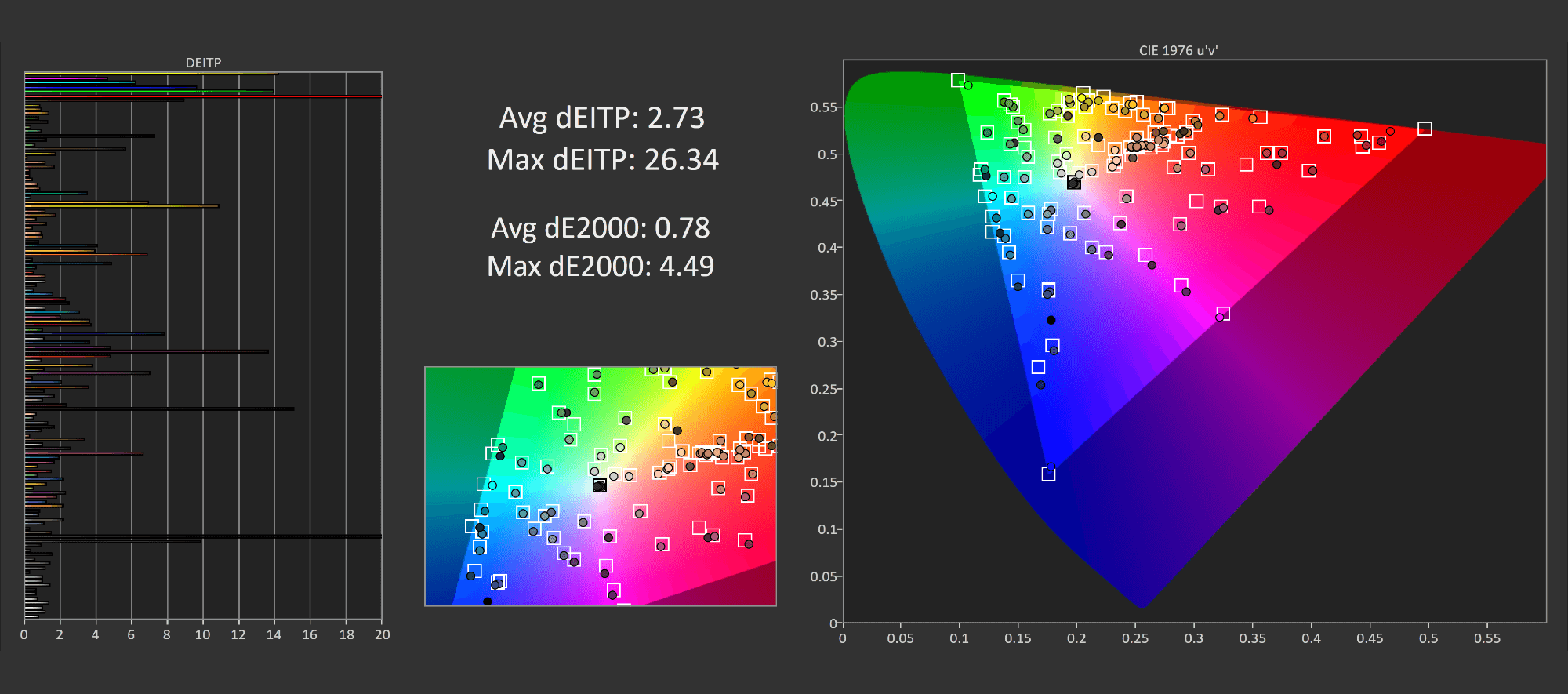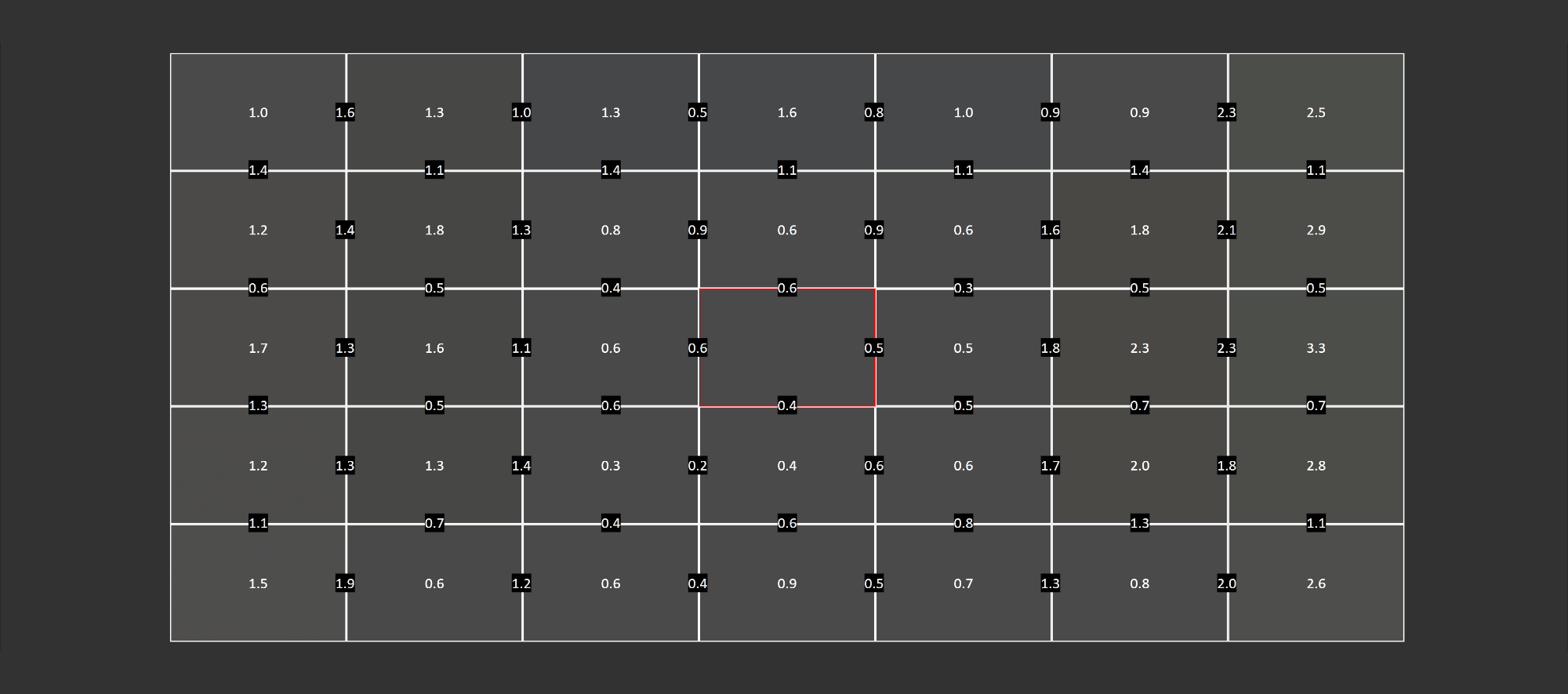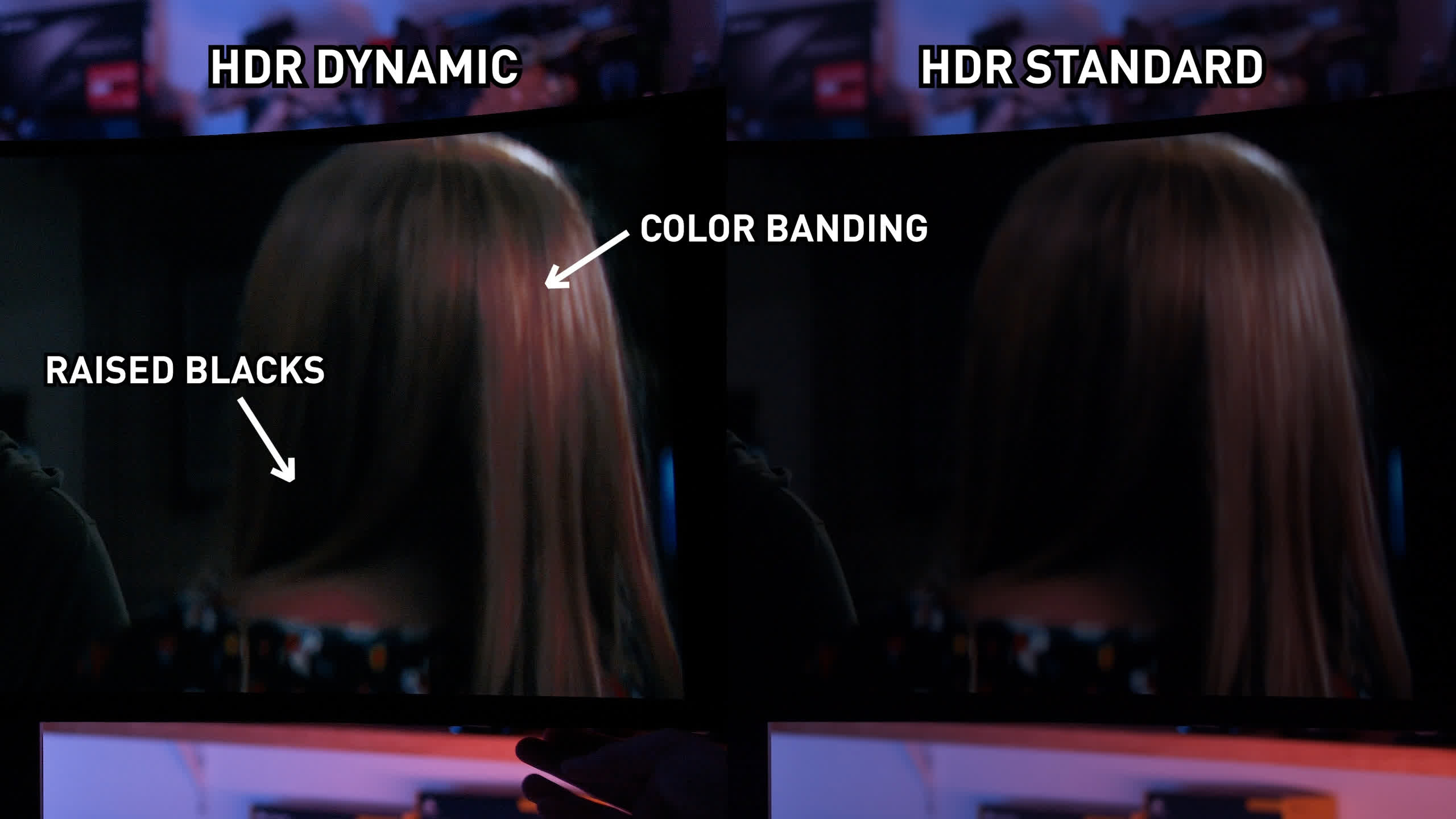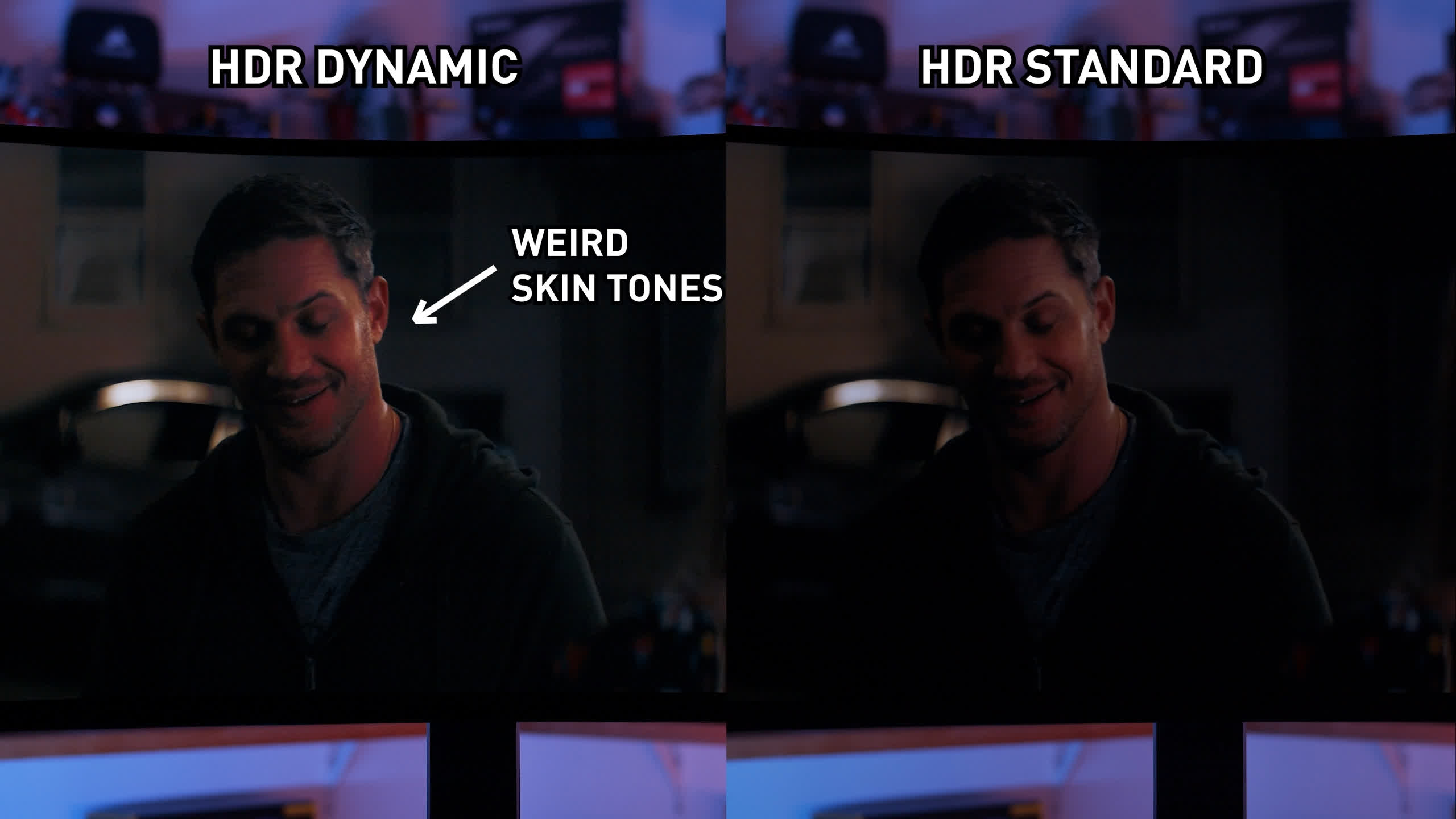The Samsung Odyssey Neo G9 is an updated version of the impressive Odyssey G9 super-ultrawide that debuted last year. This new version seeks to improve the HDR experience while retaining the basic elements of the original that made it special. The Odyssey Neo G9 remains a 49-inch 5120 x 1440 VA panel with a 1000R curvature.
At this size and resolution, it's the equivalent of two 27-inch 1440p monitors glued together into one seamless display. The refresh rate is still a very impressive 240Hz, with support for AMD FreeSync Premium Pro and Nvidia G-Sync Compatible.
The big area of improvement is HDR. The original Odyssey G9 packed a rather pathetic 10 edge lit dimming zones, which is insufficient for true HDR visuals on such a large display. Samsung has totally addressed this on the Neo, swapping out the backlight for a new mini-LED version that includes 2048 local dimming zones. In addition to that, Samsung lists support for what appears to be their own in-house HDR standard, Quantum HDR 2000, which is a bit meaningless by itself, though the spec sheet does list up to 2000 nits of peak HDR brightness.
Because we're going from a monitor with limited HDR support, to full HDR, the price tag has increased. The degree of that increase will depend heavily on your region though. In the United States, the Odyssey Neo G9 is expensive at $2,500. That's a $800 jump over the Odyssey G9's $1,700. But in Australia, to cite one example, the price tag has only increased by $400. Either way you look at it, this remains a flagship monitor sold at a premium price point.
Design and Form Factor
Aesthetically, the Odyssey Neo G9 looks the same as the monitor it's replacing. There are some subtle differences, but the general design is the same. The glossy white plastic used for the outer housing on the rear and stand remains, same wide legs with a black plastic outer, and the same RGB LED lighting element in the middle of the stand connection.
Samsung is going with a sci-fi / futuristic look and I think it works to some degree, though of course with a monitor of this size you won't be getting anything too subtle.
Speaking of size, this will be an issue for some as the Neo G9 takes up a lot of space.
The monitor is nearly 1.2 meters wide while the stand legs span 80cm, so you'll need a lot of desk real estate to fit this beast. On top of that, the overall footprint is quite large due to the aggressive 1000R curve, so you'll need some available depth as well.
This is actually wider than the LG C1 48-inch OLED we looked at a few weeks back, just without the extra height.
The 1000R curve is significant and not something I'm usually a fan of , but on an ultrawide like this I think it works quite well, especially when gaming as it gives an immersive feel.
It's not ideal for content creation or productivity work though, as there is a bit of distortion, but that will depend on how sensitive you are to those. In any case, this is a gaming focused product so overall the 1000R curve is a positive.
The stand Samsung includes is surprisingly adjustable for such a large display.
There's height adjustment as well as swivel and tilt support so it allows for a decent range of motion. I'd probably like slightly more height, though you can VESA mount it with the included adapter, and the stand is a little wobbly due to the massive size.
In addition to the HDR upgrade, another area that's received a spec boost is port selection.
We're still getting a DisplayPort 1.4 connector with DSC, which provides bandwidth for the full 5120 x 1440 resolution at 240Hz with 10-bit HDR. But the HDMI ports have been upgraded to HDMI 2.1, and there are two of them, so HDMI is no longer capped to 60Hz.
Unfortunately, despite HDMI 2.1 in theory having more bandwidth than DisplayPort 1.4, the Neo G9's HDMI 2.1 ports are still limited to 144Hz whether we're in 8-bit or 10-bit operation. I don't know why this is the case - perhaps Samsung are using a low-bandwidth HDMI 2.1 implementation - and it will be disappointing for those hoping for the full 240Hz through HDMI.
The OSD remains the same and it's controlled through a directional toggle on the bottom edge of the screen. It includes features like black boosting modes, crosshairs and various color controls. It also includes the VRR Control feature that was introduced to the Odyssey G9 firmware after launch, which should be enabled if you're having any issues with variable refresh rates. I didn't experience any flickering during my testing which was a problem some people reported with prior models.
Display Performance
Response time performance is a simple story with the Odyssey Neo G9, as it's basically unchanged from the Odyssey G9. This includes how the monitor doesn't let you change the overdrive setting when adaptive sync is enabled, and as I expect the vast majority of gamers will be using this monitor with a variable refresh rate, I'll stick to the standard default configuration.
At the maximum 240Hz, the Neo G9 is a very fast monitor. It packs a 2.8ms grey to grey response time and while there is some overshoot at this refresh rate, it's somewhat manageable and actually a bit less overshoot than the same refresh rate on the G9. This leads to excellent cumulative deviation results and negligible dark level smearing which is outstanding for a VA display.
As the refresh rate decreases, performance stays pretty balanced. At below 200Hz, overshoot drops away to be insignificant, while for the most part preserving a sub-4ms response time average with few changes to cumulative deviation. At 100Hz performance improves again as the Neo G9 actually runs this refresh rate at 200Hz on the display, and similar at 60Hz which actually runs at 180Hz, standard refresh rate duplication on a variable refresh monitor which is done to deliver the best performance. But regardless you can clearly see the Neo G9 delivers a single overdrive mode experience.

At 240Hz, the Odyssey Neo G9 is a small improvement on the original G9, both in terms of response times and overshoot. This keeps the Neo G9 as one of the fastest LCD monitors I've ever tested, although performance isn't as good as the C1 OLED. With that said, the C1 is capped to 120Hz, vs 240Hz on the Neo G9, so motion clarity when you're able to harness the high refresh rate is generally better on this VA based panel.

On average across the refresh range, the G9 and Neo G9 perform basically the same. Makes sense, as both use practically the same VA technology, with even a small improvement on the Odyssey G7. This allows this ultrawide display to beat most other contenders in the field, including products like the LG 34GN850 which isn't bad by any means for an ultrawide, but the Neo G9 is simply a lot faster.

In cumulative deviation, the Neo G9 is a small regression on the regular G9, but that still puts it in line with the Odyssey G7. I suspect this is down to Samsung pulling back slightly on overdrive at some refresh rates to minimize overshoot, it's always a delicate balance with those things but in the end it delivers a strong result.


At a fixed 120Hz refresh rate we see what I was talking about with the Neo G9 having slightly reduced overdrive which does lead to somewhat slower response times, just at lower overshoot as well. Whereas at 60Hz things go the other way with faster response times but more overshoot. No matter which chart we're looking at though, the Neo G9 has excellent response time behavior.

And that's highlighted by brilliant dark level smearing results for a VA monitor. Samsung has solved this issue with their high end VA panels, the Neo G9 is not only better than most prior-gen VA monitors, but it also competes strongly with and beats most IPS displays in this metric. Needless to say you won't be seeing any unsightly dark trails following moving objects with this monitor.

Input lag is excellent with the Neo G9, the processing delay is slightly higher than I measured with the original G9 and that may be down to the more complex mini-LED backlight and having to manage that but either way, due to the high 240Hz refresh rate and fast response times, the Neo G9 is one of the fastest monitors you can get.

Power consumption has increased by 10 percent moving from the old backlight to the new mini-LED backlight the Neo G9, making the Neo G9 a somewhat power hungry display which kind of makes sense given its size. This is only really relevant for heat output as most monitors don't consume that much power to be a significant concern, and overall the Neo G9 is similar in power consumption to two 27-inch displays which makes sense given its size.
We'll note that the Neo G9, like the original G9, does not appear to support backlight strobing. There is an MBR feature listed in the OSD, but it's greyed out for all combination of settings that I tried, which suggests that like the prior model, this feature is not accessible.
Color Performance
Color Space: Samsung Odyssey Neo G9 - D65-P3
Next up we have color performance and to be honest there's not a lot to talk about because the Odyssey Neo G9 performs just like the original G9. Wide gamut support is the same for example, at 89% DCI-P3 and 66% Rec.2020, which means the Neo G9 has a somewhat limited wide gamut that only really extends into P3 and not into Adobe RGB. Fine for HDR content and gaming, but it doesn't make the G9 as versatile as the best IPS monitors which sit at the top of this chart and provide a dual P3 and Adobe RGB experience.
Default Color Performance
Factory calibration is below average in the default, out of the box mode. Greyscale performance is off, with a gamma that's too high, meaning the monitor is a little dark most of the time. Combined with an incorrect white point, and deltaE results are a little higher than we like to see from gaming displays. It also ships without an sRGB mode enabled by default, so you will see some oversaturation, though as the gamut itself isn't particularly wide, this issue isn't going to be that bad.


When comparing these results to other gaming monitors, both the Neo G9 and G9 have very similar factory calibration in both greyscale and ColorChecker, and that leads to a below average experience. It would be great to see Samsung put more focus into this, in particular tightening up greyscale which is the most noticeable area where the Neo G9 was off relative to accurate.
OSD Tweaked Color Performance
The Neo G9 does include an sRGB mode which is average at best. The main thing this mode does is clamp the gamut down to sRGB, and it does so to a passable but not ideal degree as reds still exceeded the sRGB color space, though overall it is a large improvement on the default mode. Unfortunately, greyscale is largely unchanged, and in this mode Samsung unnecessarily locks down the greyscale controls, meaning we can't fine tune this mode. There is no reason whatsoever for these controls to be locked.
From this point, it is possible to slightly tweak the default mode to improve greyscale results, but this doesn't solve the oversaturation issue as there's no independent sRGB toggle for viewing standard content. I also found the variable backlight a little distracting at times when using desktop apps that have large uniform areas, so I'd only recommend enabling it for HDR content.
Unfortunately the "Auto" mode doesn't actually disable the variable backlight for SDR content, it just tries to smooth out the backlight so it's less noticeable. The only way to actually disable it is switching it to Off, which you then need to manually flick back to Auto for HDR. Would be nice if the Auto mode actually turned the backlight off for SDR.
Calibrated Color Performance
And here are my final calibration results using DisplayCAL. For sRGB you can achieve excellent results, you can find all the tools for great performance when calibrated for this gamut. When calibrating to P3, results aren't quite as good as the top end of the gamut is missing, so the Odyssey Neo G9 probably isn't the best monitor for any color critical P3 work, due to the gamut and the curve.

The Neo G9 provides the same peak brightness in the SDR mode as the original G9, at 430 nits or thereabouts. This is plenty for most viewing environments and while the backlight is capable of much higher brightness, it's probably not required for most people. Meanwhile, minimum brightness is solid, at around the 50 nit mark.

The Neo G9's native contrast hasn't changed significantly from the original G9. My review unit Neo G9 was better than my review unit G9, pushing contrast to around the 2300:1 mark, but this is still expected.
Of course, this is with the dynamic backlight disabled, so we are getting typical VA sorts of numbers, though nothing mind blowing as some VAs including Samsung's own Odyssey G5 can blow past 3000:1. With the variable backlight this isn't too much of an issue while gaming as we'll get to in the HDR section.
Viewing angles are nothing amazing, mostly limited by the huge curve. Uniformity on the other hand was surprisingly good, zoned backlights can have some issues with uniformity but on this panel I was impressed with how most of the image is uniform with only a small amount of vignetting around the edges. Grey uniformity isn't quite as good but still not too bad for this size of panel.
HDR Performance
Moving into the final section of this review, let's discuss the HDR experience and we'll start with our HDR checklist. The Odyssey Neo G9 packs true HDR specifications, we are getting 2048 zones, which significantly increases the possible contrast ratio and allows us to get the best out of HDR content. In addition to that we have a rated high peak brightness of 2000 nits.
The Neo G9 includes two HDR modes: HDR Standard, the default mode, and HDR Dynamic. Unfortunately, the HDR Dynamic mode isn't very usable due to it producing weird color tones and other issues at times.
I'm not sure whether this processing is intentional to create a more dynamic image in some instances, but it doesn't work well for keeping highly detailed skin tones as you can see in this side by side comparison. This was the case with both the original firmware that shipped on my review unit, and the latest 1005 firmware available from the Samsung website. So for this testing we'll be using the HDR Standard mode.

When displaying a full white window in the HDR mode, the G9 Neo can sustain 650 nits of brightness, which matches the original G9 with its lackluster backlight. I suspect Samsung have chosen to implement the exact same limitation for sustained brightness, regardless of what the backlight is actually capable of, though in most situations this level of brightness is acceptable. However, it's not as good as the PG32UQX.

In a full screen flash, the Neo G9 increases to 1290 nits of brightness, a small upgrade on the Odyssey G9 which itself was a DisplayHDR 1000 certified display. Again we're not at the same level as the PG32UQX, but still more than sufficient for most HDR content.

Then we get to sustained brightness in a 10% window and the Neo G9 is actually a regression compared to the regular G9, at 905 nits versus 1085 nits. This isn't a big deal for HDR content but it did surprise me a bit. And it only gets weirder from here.

When viewing sustained brightness versus window size, I was a bit disappointed to see the Neo G9 can't sustain 2000 nits at any window size, a bit disappointing given the PG32UQX can sustain 1700 nits with ease at a 10% window. But even more surprising was that in the HDR Standard mode, it also can't hit 2000 nits at any point even with peak brightness. In fact peak brightness is only superior than sustained in this mode at a 100% window, and at really small window sizes, which is not ideal given that if the monitor can do 1290 nits at 100% there's no reason it should be incapable of that at 10%.

So how do you actually achieve 2000 nits with this monitor? Well you have to use the HDR Dynamic mode, which as we showed earlier has weird issues with tones and other artefacts. In this mode, sustained brightness is a little higher, but the main difference is that at around a 10% window, the Neo G9 can do over 2000 nits peak. Again not quite sure why brightness falls off to below 1000 nits at a 5% window and why 2000 nits is so limited to this range of window sizes, but the Neo G9 can technically do what it says on the box.
There are also some notable brightness differences between the two modes when looking at EOTF tracking. Basically what these graphs are showing us is how well the Neo G9 is producing the exact brightness levels that the content requests. For HDR, you expect it to follow the EOTF tone curve, and that means that when 500 nits is requested, 500 nits is displayed.
What's super weird is that the HDR Dynamic mode has different EOTF behavior to HDR Standard. In the Standard mode, the image is generally too dim relative to what it should be displaying. You can see that when the content, the yellow line, requests 400 nits, the monitor is showing more like 250 nits, which doesn't give us as impressive highlights as the monitor is capable of. Meanwhile the Dynamic mode has much better adherence to the EOTF curve, but doesn't give us a linear line in the sections it needs to, which I think contributes to some of the artifacts, including raised black levels as shown in this section.
So in layman's terms, what do all of these charts mean for the Neo G9's HDR brightness?
In the Standard mode, the image looks better in terms of colors and tones, but is generally too dim relative to what it should be, and the monitor can't reach the advertised 2000 nits. In the Dynamic mode, image brightness is much better and you can hit 2000 nits, but tones look off and quite weird at times with raised black levels.
This is disappointing because the hardware clearly is ready to show excellent HDR brightness, it's just Samsung hasn't tuned it very well, even with the latest firmware. The ideal situation would be taking the high brightness of the Dynamic mode and the flat tone curve of the Standard mode and combining them into the one, excellent HDR mode that provides great image quality and the full brightness capabilities of the panel. This should be possible through a firmware revision, but you can never rely on future software updates to ever be made, so we have to review the monitor as is.
Now, to be totally fair, while the level of brightness isn't as good as it should be in the HDR Standard mode, content still looks pretty good, it's clearly giving you some level of HDR experience and brightness does get quite high at the right times. I just find it frustrating that we've got the right hardware, but the ideal use of that hardware is stuck somewhere between two software settings.
What doesn't change significantly between the two HDR modes and what remains excellent at all times is the dynamic contrast capabilities of this panel thanks to its high zone count FALD backlight. I could show you charts comparing the full screen flash contrast and ideal situation contrast ratios, but there wouldn't be much point as the backlight fully switches off at times when displaying full black. So the best case scenario for contrast with this panel is infinite contrast.

But on top of this, the Odyssey Neo G9 performs exceptionally when bright and dark areas are placed close together, a worst case scenario for LCD monitors with full array backlights.
The combination of a high zone count and VA technology means the Neo G9 is significantly better in terms of HDR contrast ratio in the worst cases than any other LCD monitor I've tested so far. We're looking at 2.5x better performance than the PG32UQX which itself isn't bad, but in practice this leads to a lot less blooming with the Neo G9 in tricky conditions like starfields compared to IPS based displays like the PG32UQX.

Even in a checkerboard test for contrast, the Neo G9 destroys its competitors, especially in the high brightness checkerboard. Results are not as good in the low brightness checkerboard, due to what I believe are similar issues to what I described previously with the HDR standard mode. But regardless, there is no doubting the Neo G9 has the best contrast capabilities I've seen yet from a gaming monitor, outside of OLED, and this is why despite some strange brightness results in some tests, the Neo G9 still looks awesome in a lot of HDR content.
What We Learned
The Samsung Odyssey Neo G9 is an excellent gaming monitor and only improves upon the foundation established with last year's model. Many areas to this monitor's performance are unchanged in the new version, but that's a good thing since Samsung was already leading the pack in areas like motion performance, especially with a VA panel.
In general, I think gamers will be very impressed with how fast this monitor is. It's got a 240Hz refresh rate, elite response times, and no dark level smearing issues which have plagued prior VA panels. The variable refresh rate experience is great, it's a huge and very immersive monitor with a perfect resolution that's still playable with modern GPUs. I'm not the biggest fan of curved monitors, but even I think the 1000R curve adds to the experience when gaming with this super-ultrawide.
Color performance is also solid and like with motion performance, remains mostly unchanged from the prior model. Same wide gamut capabilities which are decent though not amazing, same good brightness in the SDR mode, same sort of native contrast and so on. While I probably wouldn't buy an Odyssey G9 for productivity or content creation, the content consumption experience is strong.
But the big deal about the Odyssey Neo G9 is the upgrade to proper HDR capabilities: 2048 zone backlight with full array local dimming, 2000 nits of peak brightness. This provides a significant upgrade to the HDR experience.
Clearly, when you increase the backlight zone count by 200x, suddenly a new world of HDR is open, and this display ends up with the best contrast ratio I've measured yet in tricky HDR conditions with an LCD panel, only beaten by OLEDs. In many instances it looks really good, whether that's watching HDR videos or playing HDR games, and it can do this right up to 240Hz with variable refresh rates.
The only significant drawback to HDR, and really the monitor overall, are some weird brightness characteristics.
The mode that can achieve 2000 nits doesn't look great, and the other mode is a bit too dim in some instances. This isn't a hardware issue though, and I'm confident it could be addressed with a firmware update. Whether or not Samsung actually does fix it though, is another matter, but I hope they do because it's the only thing holding this display back from near perfection.
It is an expensive monitor at $2,500, no way around that. But there's nothing like it on the market, both in terms of form factor and HDR gaming capabilities. That makes it hard to judge in terms of value, but if you want this experience, Samsung gets you a solid option.
Also, as a gamer, I'd much rather have the Odyssey Neo G9 than the Asus PG32UQX which is an insane $3,000 and has a larger range of limitations, including no HDMI 2.1 – provided you are happy with an ultrawide. The other consideration is an big OLED screen like the LG C1 48" which I could understand is $1,000 cheaper, but I feel the Neo G9 is better suited to be used as a monitor. Of course, each has its pros and cons, but for the first time I feel the Odyssey Neo G9 is providing some genuine competition to favorite OLED TV options, and that's saying something.
